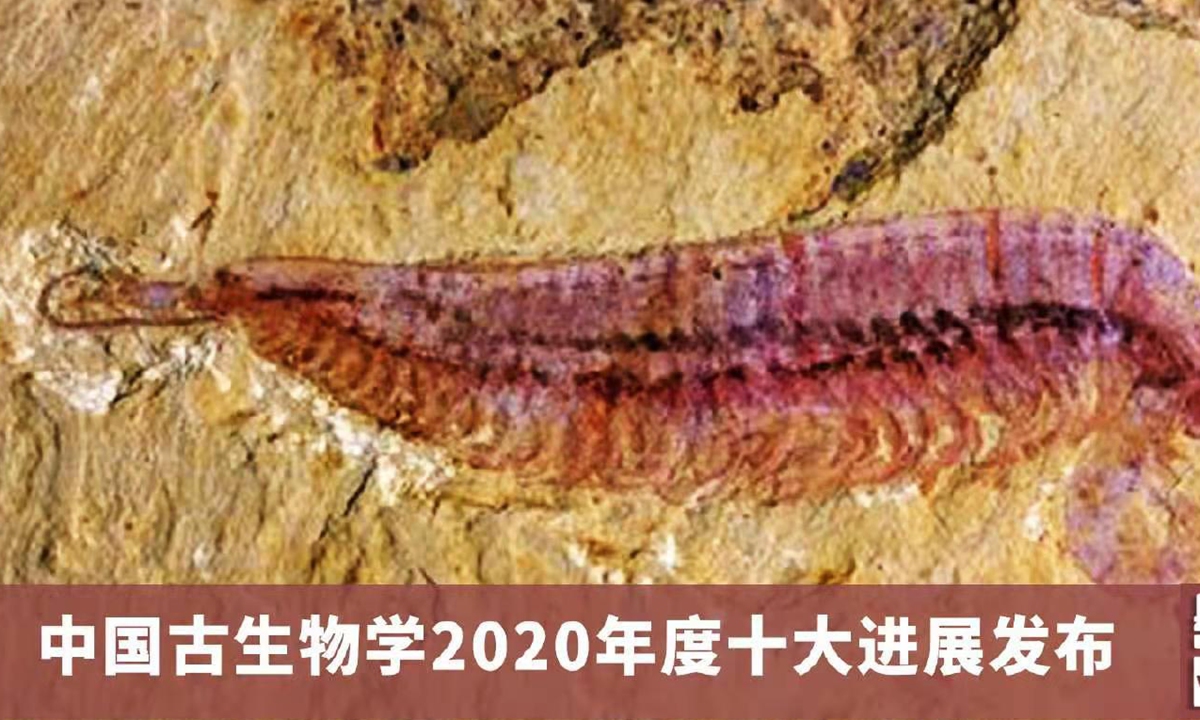ARTS / CULTURE & LEISURE
Five-eyed shrimp-like fossil highlighted as one of China’s top paleontology developments of 2020

Kylinxia fossil honored as one of the top 10 paleontology developments of 2020 in China. Photo: Weibo
A 520-million-year-old fossil that looks like a shrimp with five eyes was recently honored as one of the top 10 paleontology developments of 2020 in China.First revealed by researchers at the Nanjing Institute of Geology and Paleontology of the Chinese Academy of Sciences (NIGPAS) in November 2020, the quirky looking fossil species was spotted by the institution's "Cambrian Explosion" research team during their study of the Chengjiang fauna of the Cambrian period in Southwest China's Yunnan Province. This fauna documents comprehensive early animal fossils in the Cambrian period.
The odd-looking species has five eyes and possesses the big claws that often belong to giant predator shrimp in the ocean as well as many other characteristics of arthropods, such as the mosquitoes, insects, and crabs with which we are now familiar.
The fossil species has been named Kylinxia -xia simply means shrimp in Chinese, while Kylin refers to a Chinese mythological chimera-like creature, also spelled qilin, which is also like the fossil species that mixed with different animals' characters.
According to Huang Diying, a paleontologist at NIGPAS, Kylinxia is a very rare chimeric species. Its features such as toughened cuticles and a segmented trunk show that it was a true arthropod. However, it did not exclusively belong to the arthropod genus because it also had the morphological features of other early creatures; for instance, the 'five eyes' are identified with the Cambrian "weird wonder" Opabinia, while it also has the representative raptorial appendages of Anomalocaris, a giant apex predator in the Cambrian ocean.
"This study truly explored the evolutionary root of the true arthropods," Zhu Maoyan, a leading researcher of NIGPAS who had took apart in the project, told the Global Times on Tuesday to explain why the research result can show new development because it has indicated the evolutionary placement of Kylinxia is right between Anomalocaris and the true arthropods.
"It bridges the evolutionary gap from Anomalocaris to true arthropods and forms a key "missing link" in the origin of arthropods, contributing strong fossil evidence for the evolutionary theory of life," Zeng Han, the first author of the study published in Nature in 2020, told media.
Apart from the study of the Kylinxia fossil, the Paleontological Society of China honored nine other paleontology developments for the year 2020 in Nanjing, East China's Jiangsu Province, on Friday. The projects include a paleogenomics study that reveals the history of migration and mixing of people in northern and southern China, a study of Cretaceous amber that shows the early evolution of insects and ostracods, and a study dedicated to exploring the core value of Chengjiang fauna, which includes the Kylinxia fossil and some other animal fossils worthy of research.
